What Types Of Car Restraints Can You Use In An SUV?
There are several different kinds of dog car restraints that you can use to secure your dog in your SUV’s cargo space, although there’s no official safety standard or testing regimen for those products in the US.
However, some products work better than others, and the quality does vary.
The top three car restraint systems for dogs are:
Generally, it’s the harness or crate system that is considered to be the safest restraint mechanism. The car barrier is better than no restraint at all but keeps the dog separate from the car passenger compartment, restricting it to the cargo space.
Whichever system you decide to use for your canine companion, never put your dog in the front seat of your vehicle. The safest place for your dog to be is in the cargo space of your SUV or the car’s back seat. That said, remember that the cargo space is the crumple zone for many types of vehicles.
Now, let’s take a closer look at the main kinds of dog car restraint systems:
The dog harness restraint system is designed to work in tandem with your car’s seat belt, effectively tethering your dog to the seat rather like human seat belts. The harness keeps the dog safely in the car seat in the event of a collision, preventing the pup from shooting forward into the front cabin of the vehicle.
Dog harness systems essentially have two elements:
Whatever harness system you choose for your furry friend, the mechanism should remain firmly attached to the seat belt and prevent your dog from fidgeting around in the seat.
If you opt for a harness, here are a few essential things to consider:
Check the product labeling to see if the manufacturer has crash-tested the harness. Ideally, you want to choose a harness that’s been tested “in the field.”
You want your dog to be comfortable during his car rides with you. So, look for a harness with broad, well-padded safety straps. In particular, you want a harness that has a wide, bib-shaped strap that passes up the length of your dog’s chest. It’s that strap that takes the full force of an impact, so you want a strap that distributes that force over as wide an area as possible.
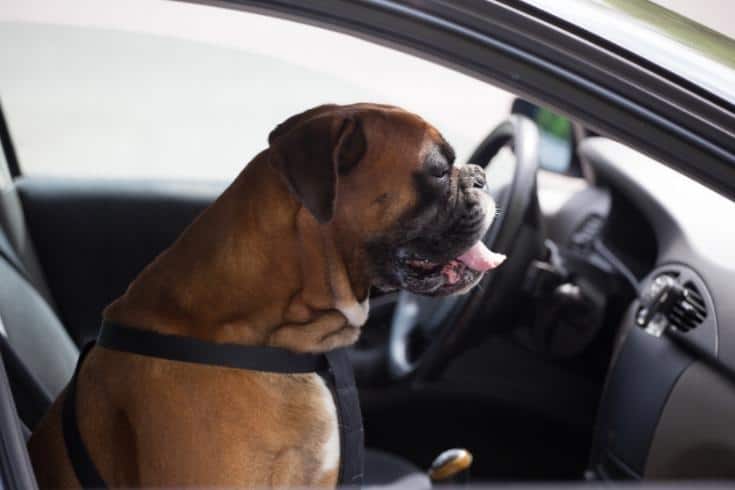
The tether attaches to the harness and then to the car seat belt. In the event of a crash, it’s the tether that stops the dog from shooting forward.
The tether must be short to keep tangling to a minimum if the dog wriggles around in the seat, and it should fix to the back of the harness. Do not use a harness that has a tether fastening at the neck.
Many dog car harnesses can be used as a standard day harness for walking your dog on his leash. That kind of design is excellent for traveling with your pet, as it means you can simply take your dog from the car, clip on his leash, and you’re good to go.
Seat belt harnesses are generally best for small to medium-sized breeds, such as Mini Goldendoodles and Bichon Frise. That said, you can also use a car harness for larger breeds, provided that the dog is well-behaved and will sit quietly in the seat.
A harness is not recommended for very boisterous, excitable dogs that won’t sit still or for very aggressive chewers.
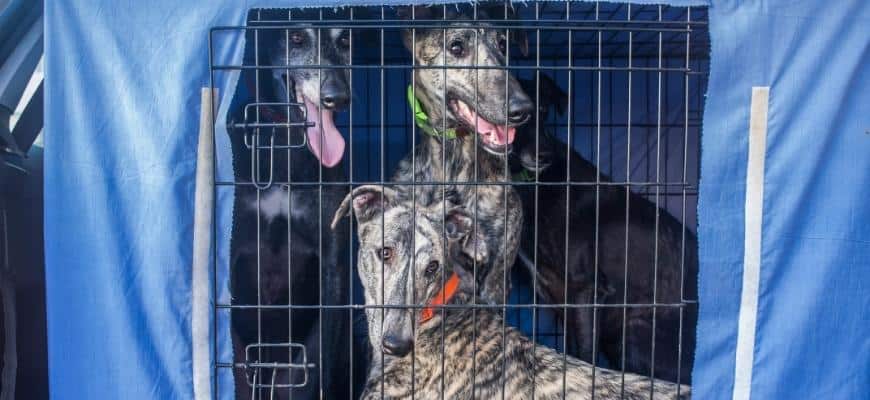
We recommend dog crates or carriers as the safest way to travel in vehicles with your dog in your SUV. Restraining your dog in a securely fixed crate reduces driver distractions and safely contains a dog in the event of a collision. Also, if you have a dog or puppy that tends to chew, your pup can’t destroy your car interior or chew his way through your rear seat belts when contained in a crate.
There are a few crucial factors to look out for when choosing a dog crate for travel, including:
You can read a detailed article on how to measure your dog for a crate in the article at this link.
It’s a good idea to print out your dog’s medical details and emergency contact information and attach them to the crate.
There are three main kinds of dog crates that can be used for travel:
All these types of crates have good and bad points; it’s really a matter of personal taste.
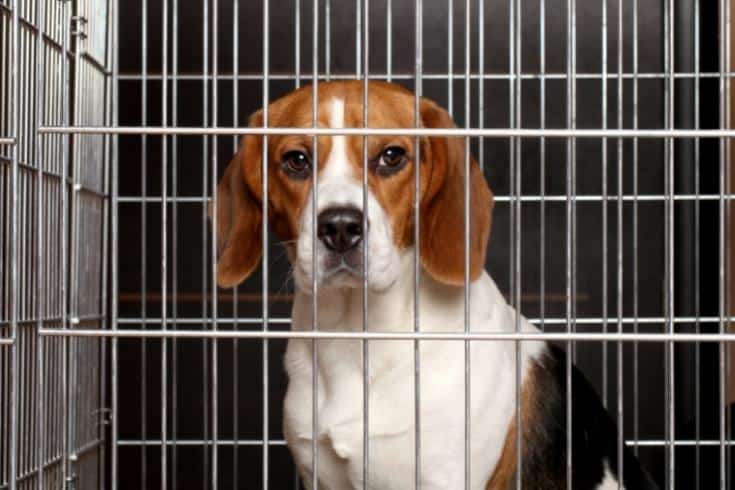
Wire dog crates can be used as the dog’s primary crate for home use and double as a travel crate.
Wire dog crates are collapsible for easy portability, so you can quickly disassemble the crate and put it into your SUV. A wire crate offers excellent ventilation, which is essential for transporting your dog on warm days. Most wire cage crates have a removable plastic tray, making cleanup quick and easy should your dog have an accident.
Wire crates are also inexpensive to buy and are long-lasting. If you plan on using your metal crate exclusively for traveling with your dog, you might want to choose a crash-tested impact-safe travel crate.
Plastic dog crates are ideal for short journeys to the vet or grooming clinic. Also, many plastic crates are airline-approved.
A plastic kennel is robust and strong, keeping your pet safer in a crash, and most have carrying handles for easy portability. Cleanup is easy; simply hose out the crate or clean it with a damp cloth and dish soap.
The main downside of plastic crates for car travel is that they don’t have especially good ventilation, which can be a problem on a warm day.
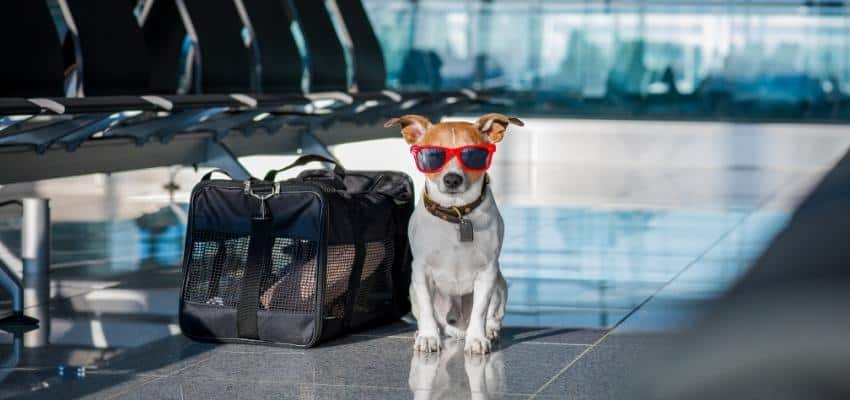
Soft-sided fabric crates can be suitable for transporting small dogs in a car or SUV.
The main downside of a fabric crate is that the soft material won’t protect your pet in a crash, and the fabric is also vulnerable to chewers.
A dog cargo area barrier or guard doesn’t provide your dog with any protection or containment in the event of an accident. A car barrier prevents the dog from moving from the cargo space of your SUV to the rear seats and won’t stop your dog from becoming a lethal projectile in a crash.
However, when used in tandem with a dog harness or crate, a barrier can be a good way of preventing driver distraction.
Here’s what to look for in a high-quality dog car barrier:
When it comes to dog car barriers, it’s true to say that you get what you pay for. Cheap products won’t be strong enough to withstand the weight of your dog in an accident and often come with fixings that are not completely secure.
So, look for a dog car barrier that’s made from very sturdy, strong materials and fixes securely to your vehicle.
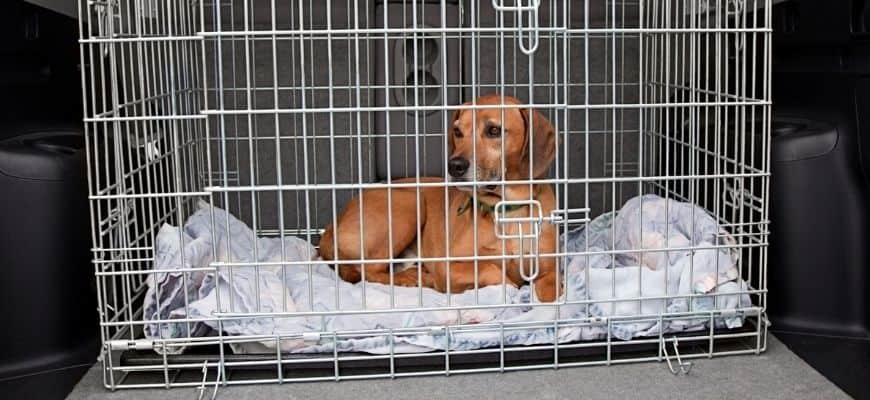
A dog car barrier is not going to do the job you want it to if it’s the wrong size and incorrectly installed.
Consult the manufacturer’s instructions to make sure that the product you choose fits your car and take the time to fix it correctly.
You can protect the interior of your SUV from dander, dirt, and scratches by fitting a trunk liner. Liners can help to keep the vehicle clean and tidy, even when Fido comes along for the ride.
Until someone designs a car with dog safety in mind, this is the best we can hope for. If you want to keep your dog safe in your car, then a harness like the Ruffwear Load Up is your best option.
In a car crash at 35 miles per hour, an unrestrained 60-pound dog becomes a 2,700-pound projectile. The force of that impact could kill both the dog and the car’s human occupants. Yet many of us drive around every day with our dogs just sitting on the back seat, or even on our laps.
Going into this research, I wasn’t aware of the importance of making sure a dog is restrained in the aftermath of an accident. But it makes sense. Kruse told me stories of dogs panicking and fleeing accidents through a broken window, only to be lost or hit by incoming traffic. He also explained that sometimes a panicked dog may delay treatment for its incapacitated owner. “With a rattled dog, some emergency responders are saying that they can’t get access to the human because the dog won’t let them get close,” he says.
Dividers and crates may help keep human occupants safe from flying dogs in a crash, as well as help keep dogs safely inside the vehicle, but they do nothing to actually protect the dog during the crash. “We don’t die from the car crash,” Kruse says. “We die from what’s called third-space impact. The car hits a brick wall—that’s the first-space impact. Your chest hits the steering wheel—that’s the second space. Your internal organs hit your rib cage—that’s the third space, and that’s where the damage is done. If you’ve got a dog in a crate, and they’re bouncing around like a marble inside that crate, then the damage is being done.”
For that reason, Kruse’s Load Up harness passed the CPS tests in sizes small and medium (dogs up to 32 inches in girth behind their front legs) but failed in larger sizes because it allows big dogs to come into contact with those front seats. You can find a list of CPS-certified products here.
Can a dog sit on a passenger’s lap?
It’s legal to take your pet in the car with you, so long as you properly restrain them, don’t let them sit in the front seats, or let them stick their head out of the window. … A seat belt harness, pet carrier, dog cage or dog guard are ways of restraining animals in cars.”
How to Transport Your Dog Safely (IN A CAR)
Probably the easiest way to secure a dog in a car is with a divider between the back seat and the load area of a wagon or SUV. Just load the dog into the back of the car, and it’s contained in a safe area, away from the human occupants.